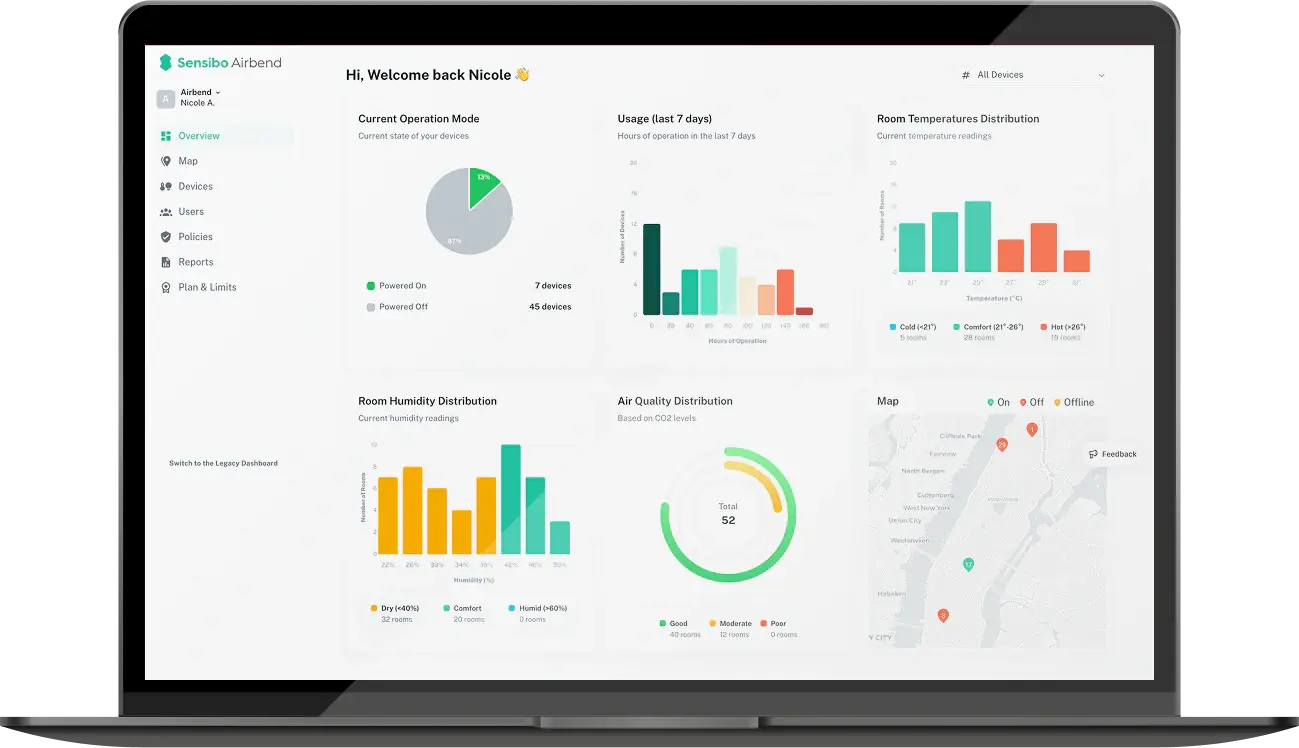Top 5 Ways to Conserve Energy at School: Smart Solutions
School utility bills pack a punch - $30,000-60,000 annually for heating and cooling in a typical elementary school. That's money that could buy textbooks, technology, or teacher supplies instead. Most schools waste 20-40% of their energy budget on preventable problems.
Energy-efficient schools need strategic approaches that tackle the biggest energy drains first. Schools have unique advantages: predictable schedules, centralized control systems, and staff who see the direct connection between energy costs and educational resources. HVAC systems for schools face specific challenges - massive heat loads during occupied hours, then nearly empty buildings for evenings, weekends, and breaks.
1. Zone-Based HVAC Control Systems: The Smart Scheduling Revolution
Traditional school HVAC system setups treat entire buildings like single units, heating or cooling empty classrooms the same as occupied ones. This approach wastes staggering amounts of energy during the 60-70% of hours when schools sit partially or completely empty.
Zone-based control divides buildings into logical sections - classroom wings, administrative areas, gymnasiums, cafeterias, and specialty rooms. Each zone operates independently based on actual occupancy and usage patterns rather than building-wide schedules.
Implementation Strategies that Work
Classroom wings by grade level:
- Elementary sections: 7:30 AM - 3:30 PM weekdays
- Middle school areas: 8:00 AM - 4:00 PM with after-school activities
- High school zones: 7:00 AM - 6:00 PM including sports/clubs
- Administrative offices: 7:00 AM - 5:00 PM year-round
Specialty areas with custom schedules:
Gymnasiums present unique scheduling challenges because they serve both educational and community functions. Cafeterias need intensive conditioning during meal periods, plus food preparation time. Computer labs demand precise temperature control based on curriculum schedules and testing requirements.
The payoff comes during shoulder seasons when only specific areas need conditioning. A 500-student elementary school might reduce HVAC runtime by 35-45% during spring and fall months.
Technology requirements:
- Programmable zone dampers in ductwork
- Individual thermostats or sensor networks
- Central control software with scheduling capabilities
- Occupancy sensors for automatic adjustments
Installation costs range from $15,000-40,000, but annual savings often reach $8,000-25,000.
2. Smart Thermostats: Precision Control That Learns Your School
Smart thermostats in schools represent one of the fastest payback investments for energy efficiency in school programs. Educational smart thermostats handle complex programming, multiple user access levels, and integration with larger building systems.
Advanced Features that Maximize Savings
Predictive heating/cooling:
- Systems start conditioning 30-60 minutes before occupancy
- Algorithms account for building thermal mass and outdoor conditions
- Automatic adjustments for seasonal changes
Multi-level access control:
Teachers get limited temperature adjustments within set ranges. Administrators have full programming and override capabilities. District officials can monitor and adjust systems remotely across multiple facilities.
Learning capabilities prove especially valuable for HVAC in school applications. Smart systems recognize that gymnasium temperatures need adjustment 45 minutes before PE classes, or that computer labs require extra cooling when all workstations operate simultaneously.
Cost-benefit analysis:
Small schools (under 300 students):
- Installation cost: $3,000-8,000
- Annual savings: $2,000-5,000
Large schools (800+ students):
- Installation cost: $20,000-50,000
- Annual savings: $12,000-30,000
3. Strategic Air Filter Management: The Hidden Energy Drain
Air filter management represents a massive energy waste opportunity in most schools. Dirty filters force HVAC equipment to work 15-25% harder to move air through buildings, directly increasing electricity consumption and equipment wear.
Energy-efficient schools implement systematic filter programs that go beyond monthly replacements.
Filter Selection Strategies
MERV rating optimization:
General classrooms perform well with MERV 8-10 filters that capture dust and pollen without excessive airflow restriction. Computer labs benefit from MERV 11-13 filters for enhanced particle removal. Nurse stations may require MERV 14-16 filters despite higher energy costs.
Replacement timing based on conditions:
- High-traffic areas: Monthly during school year
- Standard classrooms: Every 6-8 weeks
- Administrative areas: Quarterly replacement
- High pollen seasons: More frequent changes
Monitoring systems:
Pressure differential sensors provide electronic monitoring of filter condition with automatic alerts when replacement is needed. Visual inspection programs include monthly condition checks and staff training on filter assessment.
Financial impact extends beyond energy savings. Clean filters reduce equipment maintenance costs, extend HVAC system life, and improve indoor air quality that supports better student attendance.
4. Occupancy-Based Ventilation Control: Fresh Air Without Energy Waste
Traditional school HVAC system designs pump fresh outdoor air continuously during occupied hours, regardless of actual occupancy levels. This wastes enormous energy heating or cooling outdoor air for empty classrooms.
Occupancy-based ventilation adjusts fresh air intake based on real-time occupancy rather than maximum design capacity.
Technology Components
CO2 sensor networks:
- Individual sensors in each classroom and common area
- Continuous monitoring of air quality levels
- Automatic fresh air adjustments based on occupancy
Demand-controlled ventilation systems:
Variable speed fans adjust airflow rates while modulating dampers provide precise fresh air control. Energy recovery ventilators condition incoming air using exhaust air energy.
Energy savings come from reducing unnecessary outdoor air conditioning during low-occupancy periods. A classroom designed for 30 students might only have 15 students during certain periods, requiring 50% less fresh air intake.
Ventilation by space type:
Standard classrooms require 15 CFM per person minimum during occupied periods, with dramatic reductions possible during unoccupied times.
Gymnasiums and auditoriums benefit from predictive ventilation that begins conditioning 30-60 minutes before events while maintaining minimal fresh air intake between uses.
Cafeterias need enhanced ventilation during meal periods, but can operate with reduced fresh air between meals.
Health benefits complement energy savings. Proper ventilation reduces airborne illness transmission and improves cognitive performance. Studies show optimized ventilation can reduce student sick days by 10-15%.
Implementation costs:
- CO2 sensor network: $5,000-15,000
- Demand-controlled ventilation upgrades: $15,000-40,000
- Annual energy savings: $8,000-25,000
5. Building Envelope Upgrades: The Foundation of Efficiency
Building envelope improvements create the foundation that makes all other energy-saving strategies for schools more effective. Windows, insulation, air sealing, and roofing work together to reduce heating and cooling loads.
Schools built before 1990 often have minimal insulation, single-pane windows, and significant air leakage that forces HVAC systems to work overtime.
Priority Upgrade Sequence
Phase 1: Air sealing and weather stripping
- Seal gaps around windows, doors, and utility penetrations
- Weather strip all exterior doors and operable windows
- Caulk interior gaps that allow conditioned air loss
Phase 2: Insulation improvements
- Attic insulation to current code levels (R-38 to R-60)
- Wall insulation where accessible during renovations
- Pipe and ductwork insulation in unconditioned spaces
Phase 3: Window and door replacements
High-performance windows with low-E coatings provide the biggest impact. Proper sizing and installation with thermal breaks prevent energy loss. Solar control features help with south and west exposures.
Implementation Strategies
Timing upgrades with other projects maximizes efficiency. Roof replacement provides opportunities for insulation upgrades. HVAC renovations should include ductwork sealing. Summer maintenance periods allow envelope work without disrupting classes.
Phased implementation should prioritize the worst-performing areas first. Group upgrades by contractor type and season to reduce costs and coordination complexity.
Performance benefits compound over time. Better building envelopes reduce HVAC system sizing requirements, lower maintenance costs, and improve comfort consistency.
 Tracking Your Success
Tracking Your Success
How to save energy at school programs succeed when schools track results systematically. Simple monitoring reveals which initiatives deliver the biggest savings.
Key Performance Indicators
Energy consumption metrics:
- Monthly utility costs compared to previous years
- Energy use per square foot of building space
- Peak demand charges and timing
Operational efficiency measures:
- Equipment runtime hours and cycling patterns
- Maintenance costs and service call frequency
- Indoor comfort complaints and resolution time
Smart building systems generate enormous data, but schools need actionable metrics. Weekly energy reports, monthly cost summaries, and annual performance reviews provide appropriate detail levels.
Making Energy Conservation Work
Energy savings for schools extend beyond reduced utility bills. These five strategies work together - zone controls, smart thermostats, filter management, ventilation optimization, and envelope upgrades. Each improvement makes others more effective.
Schools achieving 20-30% energy reductions often reinvest savings into additional efficiency measures, creating positive feedback loops. The financial case grows stronger each year as utility costs rise and efficiency technologies become more affordable. Schools implementing energy efficiency programs now position themselves for decades of reduced operating costs while creating healthier learning environments.






































.jpg?height=200&name=photo_2024-11-01_21-36-00%20(1).jpg)
.jpg?height=200&name=empty-modern-coworking-office-environment-with-panoramic-windows%20(1).jpg)
.jpg?height=200&name=photo_2024-07-05_21-25-23%20(1).jpg)


